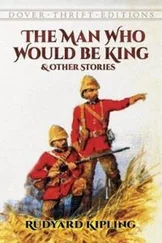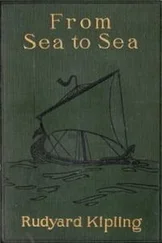"What's our level?" I ask.
"Four thousand. Aren't you coming up on the bridge?"
The bridge (let us ever praise the G.P.O. as a repository of ancientest tradition!) is represented by a view of Captain Hodgson's legs where he stands on the Control Platform that runs thwart–ships overhead. The bow colloid is unshuttered and Captain Purnall, one hand on the wheel, is feeling for a fair slant. The dial shows 4300 feet. "It's steep to–night," he mutters, as tier on tier of cloud drops under. "We generally pick up an easterly draught below three thousand at this time o' the year. I hate slathering through fluff."
"So does Van Cutsem. Look at him huntin' for a slant!" says Captain Hodgson. A foglight breaks cloud a hundred fathoms below. The Antwerp Night Mail makes her signal and rises between two racing clouds far to port, her flanks blood–red in the glare of Sheerness Double Light. The gale will have us over the North Sea in half–an–hour, but Captain Purnall lets her go composedly—nosing to every point of the compass as she rises.
"Five thousand–six, six thousand eight hundred"—the dip–dial reads ere we find the easterly drift, heralded by a flurry of snow at the thousand fathom level. Captain Purnall rings up the engines and keys down the governor on the switch before him. There is no sense in urging machinery when Eolus himself gives you good knots for nothing. We are away in earnest now—our nose notched home on our chosen star. At this level the lower clouds are laid out, all neatly combed by the dry fingers of the East. Below that again is the strong westerly blow through which we rose. Overhead, a film of southerly drifting mist draws a theatrical gauze across the firmament. The moonlight turns the lower strata to silver without a stain except where our shadow underruns us. Bristol and Cardiff Double Lights (those statelily inclined beams over Severnmouth) are dead ahead of us; for we keep the Southern Winter Route. Coventry Central, the pivot of the English system, stabs upward once in ten seconds its spear of diamond light to the north; and a point or two off our starboard bow The Leek, the great cloud–breaker of Saint David's Head, swings its unmistakable green beam twenty–five degrees each way. There must be half a mile of fluff over it in this weather, but it does not affect The Leek.
"Our planet's over–lighted if anything," says Captain Purnall at the wheel, as Cardiff–Bristol slides under. "I remember the old days of common white verticals that 'ud show two or three hundred feet up in a mist, if you knew where to look for 'em. In really fluffy weather they might as well have been under your hat. One could get lost coming home then, an' have some fun. Now, it's like driving down Piccadilly."
He points to the pillars of light where the cloud–breakers bore through the cloud–floor. We see nothing of England's outlines: only a white pavement pierced in all directions by these manholes of variously coloured fire—Holy Island's white and red—St. Bee's interrupted white, and so on as far as the eye can reach. Blessed be Sargent, Ahrens, and the Dubois brothers, who invented the cloud–breakers of the world whereby we travel in security!
"Are you going to lift for The Shamrock?" asks Captain Hodgson. Cork Light (green, fixed) enlarges as we rush to it. Captain Purnall nods. There is heavy traffic hereabouts—the cloud–bank beneath us is streaked with running fissures of flame where the Atlantic boats are hurrying Londonward just clear of the fluff. Mail–packets are supposed, under the Conference rules, to have the five–thousand–foot lanes to themselves, but the foreigner in a hurry is apt to take liberties with English air. "No. 162" lifts to a long–drawn wail of the breeze in the fore–flange of the rudder and we make Valencia (white, green, white) at a safe 7000 feet, dipping our beam to an incoming Washington packet.
There is no cloud on the Atlantic, and faint streaks of cream round Dingle Bay show where the driven seas hammer the coast. A big S.A.T.A. liner (Societe Anonyme des Transports Aeriens) is diving and lifting half a mile below us in search of some break in the solid west wind. Lower still lies a disabled Dane she is telling the liner all about it in International. Our General Communication dial has caught her talk and begins to eavesdrop. Captain Hodgson makes a motion to shut it off but checks himself. "Perhaps you'd like to listen," he says.
"Argol of St. Thomas," the Dane whimpers. "Report owners three starboard shaft collar–bearings fused. Can make Flores as we are, but impossible further. Shall we buy spares at Fayal?"
The liner acknowledges and recommends inverting the bearings. The Argol answers that she has already done so without effect, and begins to relieve her mind about cheap German enamels for collar–bearings. The Frenchman assents cordially, cries "Courage, mon ami," and switches off.
Then lights sink under the curve of the ocean.
"That's one of Lundt & Bleamers' boats," says Captain Hodgson. "Serves 'em right for putting German compos in their thrust–blocks. She won't be in Fayal to–night! By the way, wouldn't you like to look round the engine–room?"
I have been waiting eagerly for this invitation and I follow Captain Hodgson from the control–platform, stooping low to avoid the bulge of the tanks. We know that Fleury's gas can lift anything, as the world–famous trials of '89 showed, but its almost indefinite powers of expansion necessitate vast tank room. Even in this thin air the lift–shunts are busy taking out one–third of its normal lift, and still "162" must be checked by an occasional downdraw of the rudder or our flight would become a climb to the stars. Captain Purnall prefers an overlifted to an underlifted ship; but no two captains trim ship alike. "When I take the bridge," says Captain Hodgson, "you'll see me shunt forty per cent of the lift out of the gas and run her on the upper rudder. With a swoop upward instead of a swoop downward, as you say. Either way will do. It's only habit. Watch our dip–dial! Tim fetches her down once every thirty knots as regularly as breathing."
So is it shown on the dip–dial. For five or six minutes the arrow creeps from 6700 to 7300. There is the faint "szgee" of the rudder, and back slides the arrow to 6000 on a falling slant of ten or fifteen knots.
"In heavy weather you jockey her with the screws as well," says Captain Hodgson, and, unclipping the jointed bar which divides the engine–room from the bare deck, he leads me on to the floor. Here we find Fleury's Paradox of the Bulk–headed Vacuum—which we accept now without thought—literally in full blast. The three engines are H.T.&T. assisted–vacuo Fleury turbines running from 3000 to the Limit—that is to say, up to the point when the blades make the air "bell"—cut out a vacuum for themselves precisely as over–driven marine propellers used to do. "162's" Limit is low on account of the small size of her nine screws, which, though handier than the old colloid Thelussons, "bell" sooner. The midships engine, generally used as a reinforce, is not running; so the port and starboard turbine vacuum–chambers draw direct into the return–mains.
The turbines whistle reflectively. From the low–arched expansion–tanks on either side the valves descend pillarwise to the turbine–chests, and thence the obedient gas whirls through the spirals of blades with a force that would whip the teeth out of a power saw. Behind, is its own pressure held in leash of spurred on by the lift–shunts; before it, the vacuum where Fleury's Ray dances in violet–green bands and whirled turbillons of flame. The jointed U–tubes of the vacuum–chamber are pressure–tempered colloid (no glass would endure the strain for an instant) and a junior engineer with tinted spectacles watches the Ray intently. It is the very heart of the machine—a mystery to this day. Even Fleury who begat it and, unlike Magniac, died a multi–millionaire, could not explain how the restless little imp shuddering in the U–tube can, in the fractional fraction of a second, strike the furious blast of gas into a chill greyish–green liquid that drains (you can hear it trickle) from the far end of the vacuum through the eduction–pipes and the mains back to the bilges. Here it returns to its gaseous, one had almost written sagacious, state and climbs to work afresh. Bilge–tank, upper tank, dorsal–tank, expansion–chamber, vacuum, main–return (as a liquid), and bilge–tank once more is the ordained cycle. Fleury's Ray sees to that; and the engineer with the tinted spectacles sees to Fleury's Ray. If a speck of oil, if even the natural grease of the human finger touch the hooded terminals, Fleury's Ray will wink and disappear and must be laboriously built up again. This means half a day's work for all hands and an expense of, one hundred and seventy–odd pounds to the G.P.O. for radium–salts and such trifles.
Читать дальше












